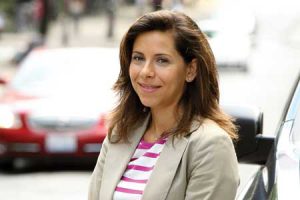
By Katherine Gombay
It’s a bit like watching a 3D Etch A Sketch in action, with lines and icons of different colours moving across the computer screen. But, though it looks like a fun toy, it’s actually a very complex traffic simulation tool that will help Plateau Mont-Royal planners smooth traffic flow over the coming months. And by working with this useful instrument Marianne Hatzopoulou, a professor of civil engineering, has played an important role in the process.
Hatzopoulou and her students use Vissim software, which is so multi-faceted it allows them to track real traffic patterns – down to the level of the actual speeds of individual cars, cyclists or pedestrians as they move through the Plateau. They are also able to track where the cars come from, an essential piece of information to help with traffic planning.
Using satellite imagery, the team builds a grid of the existing streets in the borough. They then add a second layer to the grid that shows all the intersections, including every traffic light detail, right down to how much time each light is green, amber and red. The third layer, which is based on hard data such as traffic counts, adds the pedestrians, the cyclists and the cars to the model. “We’re simulating the entire Plateau and you can see every single car stopping at intersections and moving and turning – the visuals are really cool,” said Hatzopoulou.
Using the grid, Hatzopoulou can simulate how traffic flow will be affected if a stop sign is added in one place, a bike lane is added somewhere else, or if the cycle times of certain traffic lights are changed. On the screen the multi-coloured lines and icons representing streets, cars, pedestrians and bicycles re-etch themselves as the researchers make changes to the data. “It’s the work of a lifetime building this kind of tool,” explained Hatzopoulou. “We keep adding to it and making it more realistic.”
But this isn’t just about helping people get from Point A to Point B in a more timely fashion. Traffic flow has a direct effect on the quality of our air. “One significant variable in air pollution is the way that you’re driving your car,” said Hatzopoulou. “Idling, stop-and-go driving and aggressive driving all result in higher emissions of air pollutants. We will be looking at both the traffic and the generation of car emissions to see how we can optimize the system and reduce emissions. The Plateau is a good case study because these are dense neighbourhoods with lots of people living and moving around on the streets.”
But it’s this very density of housing, businesses and population that is partly responsible for the problems with the urban air quality. “Because you have tall buildings on both sides of a street, you limit the dilution of air pollution caused by traffic,” said Hatzopoulou. She is quick to point out that, ironically, this means the people who are helping to reduce air pollution, pedestrians and cyclists, are those who are likely to be the most affected by it. As a result, Hatzopoulou and her students are also monitoring pollution levels around the city.
Hatzopoulou and her team will continue to add to the model, and she hopes that other Montreal boroughs may use it to help them make changes to traffic patterns. But she cautions that the model is not about predicting the future. “The model is not going to tell the policy-maker what to do. It’s just another voice around the table,” she said. But it’s a voice that Plateau policy-makers believe will help reduce traffic problems and air emissions and they’re listening hard to what it has to say.
